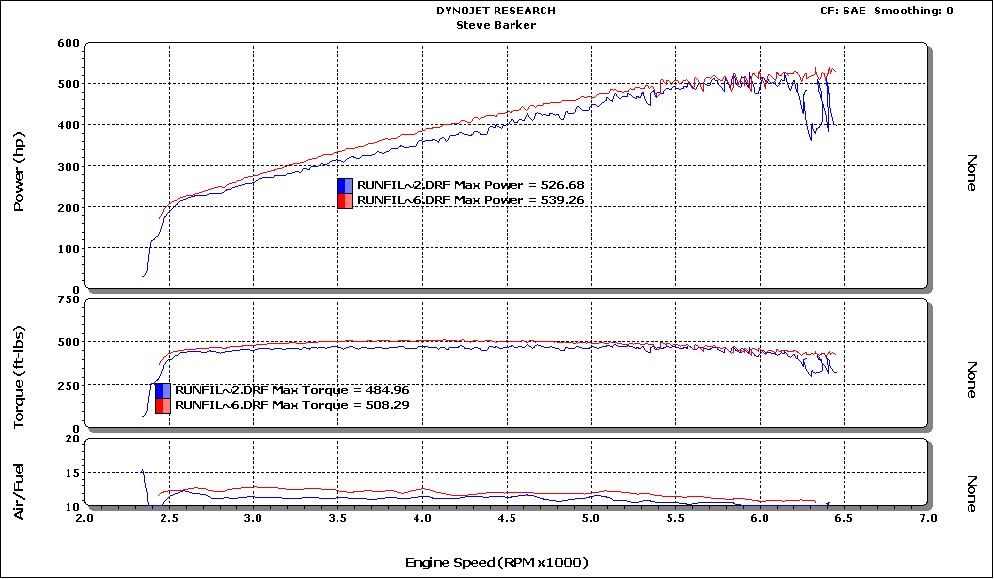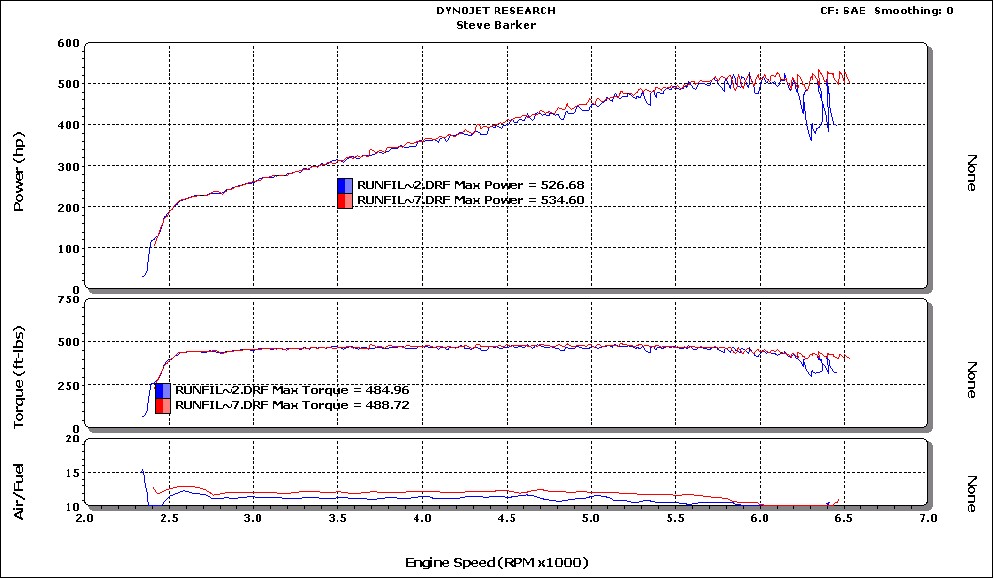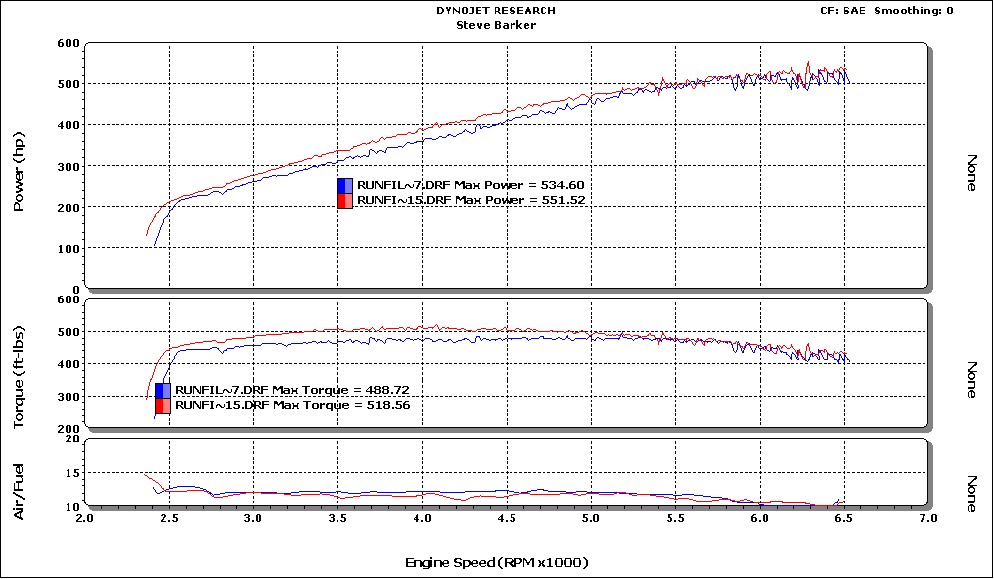Since this is my first post to this forum, I thought I would make it an informational one. I purchased my GT about a month ago and have been chomping at the bit to get it on my DynoJet. This is the first Ford I have ever owned. After 280 miles I decided it was time.
I purchased the Accufab X-Pipe exhaust, an SCT Flash Tuner with Accufabs calibration, and an Air Inlet Support.
Since I have a DynoJet in my shop at home, I am able to do extensive testing without regard for time. I made a total of 16 runs this weekend with very good results. What I wanted to do was determine the power increase from the SCT Tuner with the stock exhaust, the Accufab X-Pipe with the stock tune, and the Accufab X-Pipe with the SCT/Accufab tune.
The following graphs will illustrate the results.
On this first graph, RUNFIL~2.DRF is totally stock with the stock exhaust. RUNFIL~6.DRF is with the stock exhaust and SCT/Accufab tune.

On this second graph, RUNFIL~2.DRF is totally stock with the stock exhaust. RUNFIL~7.DRF is with the Accufab X-Pipe and the stock tune.

On this third graph, RUNFIL~7.DRF is with the Accufab X-Pipe and the stock tune. RUNFIL~15.DRF is with the Accufab X-Pipe and the SCT/Accufab tune.

I make it a point to try to duplicate conditions for every run. It took me a few runs to determine what temperature this car liked to run at. It appears the best runs happen between 170* and 180*. All the runs are SAE corrected. The UNCORRECTED numbers for the best run are 563 rwhp and 529 rwtq. The STD corrected numbers for the best run are 566 rwhp and 532 rwtq.
I have made appx. 500 runs on my DynoJet and these are the first runs I have seen that are this jagged. I have seen a magazine article with graphs posted that were also jagged like this. I believe that SCT has another system that will allow me to log and modify the ECM. This is what I will purchase next. I typically use a Racepak data acquisition system to log my runs but I was unable to hook it up for a number of reasons.
I also weighed the factory muffler and the Accufab 'X' pipe. The factory muffler weighs 55#12oz while the Accufab 'X' pipe and brackets weigh 13#. This amounts to a weight savings of 42#12oz.
All in all I am very impressed with the Ford GT. Did I mention this was the first Ford I have ever owned?
Steve
I purchased the Accufab X-Pipe exhaust, an SCT Flash Tuner with Accufabs calibration, and an Air Inlet Support.
Since I have a DynoJet in my shop at home, I am able to do extensive testing without regard for time. I made a total of 16 runs this weekend with very good results. What I wanted to do was determine the power increase from the SCT Tuner with the stock exhaust, the Accufab X-Pipe with the stock tune, and the Accufab X-Pipe with the SCT/Accufab tune.
The following graphs will illustrate the results.
On this first graph, RUNFIL~2.DRF is totally stock with the stock exhaust. RUNFIL~6.DRF is with the stock exhaust and SCT/Accufab tune.

On this second graph, RUNFIL~2.DRF is totally stock with the stock exhaust. RUNFIL~7.DRF is with the Accufab X-Pipe and the stock tune.

On this third graph, RUNFIL~7.DRF is with the Accufab X-Pipe and the stock tune. RUNFIL~15.DRF is with the Accufab X-Pipe and the SCT/Accufab tune.

I make it a point to try to duplicate conditions for every run. It took me a few runs to determine what temperature this car liked to run at. It appears the best runs happen between 170* and 180*. All the runs are SAE corrected. The UNCORRECTED numbers for the best run are 563 rwhp and 529 rwtq. The STD corrected numbers for the best run are 566 rwhp and 532 rwtq.
I have made appx. 500 runs on my DynoJet and these are the first runs I have seen that are this jagged. I have seen a magazine article with graphs posted that were also jagged like this. I believe that SCT has another system that will allow me to log and modify the ECM. This is what I will purchase next. I typically use a Racepak data acquisition system to log my runs but I was unable to hook it up for a number of reasons.
I also weighed the factory muffler and the Accufab 'X' pipe. The factory muffler weighs 55#12oz while the Accufab 'X' pipe and brackets weigh 13#. This amounts to a weight savings of 42#12oz.
All in all I am very impressed with the Ford GT. Did I mention this was the first Ford I have ever owned?
Steve

